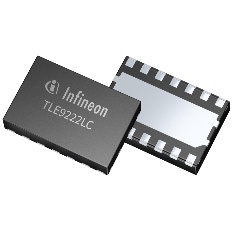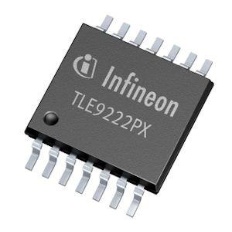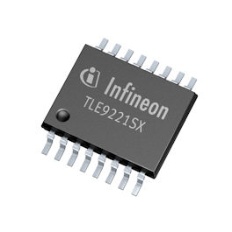
Because of the increasing demand for data exchange in modern vehicles, the automotive industry has implemented a range of automotive networks that efficiently send and receive large quantities of data. These include protocols such as CAN (Controller Area Network) and LIN (Local Interconnect Network) bus systems.
As the future of the industry develops, and EVs conquer the market, vehicles will include more electronic control units (ECUs) that build on these types of in-vehicle connectivity. Therefore, the importance of in-vehicle networking (IVN) devices will grow with increasing quantities of data exchanged between ECUs and of course the extended number of ECUs itself. As a result, the automotive industry established automotive networking systems such as the CAN FD (Flexible Data-rate) protocol, CAN PN – Partial Networking for improved energy efficiency – and very recently the CAN FD SIC with Signal Improvement Capability which will boost CAN communication up to a speed of 8Mbit/s.
Infineon offers a broad product portfolio of automotive transceivers for these different bus segments, all of which perfectly suited for the challenging automotive environment and that are designed to meet and exceed the latest ESD and EMC requirements.
Depending on the respective vehicle network architecture and the related ECU supply path, different transceiver types are used. Infineon automotive transceivers ensure reliable in-vehicle connectivity and communication, helping to minimize the current consumption and the related CO 2-emissions at the vehicle level.
Infineon automotive transceiver products provide the best value through high performance, robust manufacture, and reliability.
The Infineon portfolio includes a range of different types of automotive transceivers centered around the LIN and CAN protocols. The differences between the two protocols are the speeds of communication. LIN is used in low-speed applications and CAN in medium-speed applications.
Having said this, each of the protocols complements one another when used within in-vehicle networks, helping to connect all types of vehicle systems, as well as peripheral devices. For example, while CAN is ideal for use with error-sensitive systems on a 5-V differential, LIN is used within applications with low-bandwidth requirements on a 12-V single-wire bus.
Key Features
Our automotive transceiver portfolio includes the following:
Initially the CAN technology had been invented to offer robust and scalable networks in the car. With faster data rate it turned out to be more difficult to keep this robustness. Developing complex networks with low data rates e.g. 500kbit/s or 1Mbit/s had been comparable easy. Faster networks using 2Mbit/s or 5Mbit/s data rate could be only realized in smaller and less complex networks. Modern networks require both: high data rates in stable networks. This signal integrity can be granted with the newly developed CAN SIC Transceivers.
The CAN FD SIC actively improve CAN signals to ensure robust communication in large networks and at faster bit rates. Signal ringing, an artifact of large, complex networks with unterminated stubs, is dramatically reduced, removing previous limitations in network topologies. Even lower specification cabling solutions can be considered.
Our range of CAN transceivers automotive CAN transceiver provides durable and robust design made for challenging automotive applications and that meet or exceed the latest ESD and EMC requirements.
The LIN automotive protocol was developed to deliver low-speed data transfer rates over a single wire, allow the implementation of cheap and efficient hardware-nodes within vehicles. The CAN bus has generally been viewed as too costly to run all in-vehicle network components, and so the LIN bus was developed to deliver standardised simpler systems and provide greater compatibility in tandem with CAN.
This means that serial network connections between actuators, sensors or switches and an ECU can be designed efficiently and at lower costs for vehicle manufactures, allowing other protocols to manage more sensitive operations.
Infineon’s range of automotive LIN transceivers meet or exceed the latest ESD and EMC requirements and are designed to meet the challenges of the automotive industry.
Built to succeed the popular LIN protocol, CXPI (Clock eXtension Peripheral Interface) reduces materials costs during manufacturing and lowers fuel consumption in vehicles by requiring fewer wire harnesses. This is done by integrating the CSMA/CR system (event initiate system) into the polling system of LIN.
This ensures higher response time and scalability, and significantly reduces HMI and development costs, as well as reducing the number of the parts needed for the clock side of the design. Additionally, reliability is improved by cross-communication between slaves, a secondary clock master function and a CRC.
Our range of CXPI transceivers are improve in-vehicle connectivity through reliable, low-noise components made for the automotive industry.
Designed for the future requirements of In Vehicle Networks (IVN) – data transmission rates up to 10Mbps.
FlexRay™ is a serial, deterministic bus system for real-time control applications and is designed for the future requirements of In Vehicle Networks (IVN), providing data transmission rates up to 10Mbps. FlexRay™ realizes bus communication without data collision. The nodes do not arbitrate and the FlexRay™ Communication Controller (CC) guarantees a collision free bus access during normal operation. The FlexRay™ transceiver is a Bus Driver (BD) and it accomplishes the physical interface between the Communication Controller and the Bus medium.
Infineon‘s FlexRay™ Transceivers are fully compliant to the FlexRay™ Physical Layer Specification V3.0.1 and are offered in different package variants.



High speed CAN Transceivers with up to 8Mb/s transmission speed for automotive & many other applications.
Initially the CAN technology had been invented to offer robust and scalable networks in the car. With faster data rate it turned out to be more difficult to keep this robustness. Developing complex networks with low data rates e.g. 500kbit/s or 1Mb/s had been comparable easy. Faster networks using 2Mb/s or 5Mb/s data rate could be only realized in smaller and less complex networks. The ringing of a lower date rate network could be compensated with time, but with high data rate this bit time is not available any more. Never the less modern networks require both: high data rates in stable networks. This signal integrity can be granted with the newly developed CAN SIC Transceivers.
This technology will reduce costs and simplify designs for network architects and consequently impact significantly existing CAN FD networks.
With the new CAN FD SIC technology we complete the CAN transceiver offering, supporting networks with 500kbit/s up to 8Mb/s transmission rates.
Infineon is offering a modular LIN portfolio from high-end to basic single channel LIN transceivers and additionally integrated variants like a DUAL LIN as well as a LIN-LDO.
By allowing a basic serial network connection between actuators, sensors or switches and an ECU, the LIN (Local Interconnect Network) bus has tremendously reduced the design efforts and costs for the car manufacturers. It is thus used in a fast growing number of applications, mainly for low speed networking (up to 20kBaud) in Body and Interior applications and for the exchange of comfort related data.
Low noise, automotive-grade Clock eXtension Peripheral Interface (CXPI) transceivers
CXPI (Clock eXtension Peripheral Interface) is designed to succeed the widely-used Local Interconnect Network (LIN) automotive communication protocol. CXPI reduces the bill-of-material costs and lower fuel consumption by requiring fewer wire harnesses in a vehicle. Infineon offers CXPI transceivers, as well as automotive MCUs – a complete solution for your automotive design needs.
CXPI has the CSMA/CR system (event initiate system) built into the polling system of LIN, provides higher response time and scalability, and significantly reduces HMI and development costs.
CXPI has reduced the number of the parts needed for the clock side of the design because a data and a clock can transmit at the same time by adoption of PWM. Furthermore, reliability improves by a communication between slaves, a secondary clock master function and a CRC.
The S6BT112A01 and S6BT112A02 are integrated transceiver IC for Automotive communication network with Clock eXtension Peripheral Interface (CXPI). It is flexible bit rate from 2.4 k bit per second to 20 k bit per second with JASO CXPI compliant. This CXPI transceiver IC connect between CXPI data link controller and CXPI Bus line, and enables to connect to vehicle battery directly, with high surge protection. Additionally a product has optional function for Spreads Spectrum Clock Generator (SSCG). In the standby operation, S6BT112A01 and S6BT112A02 success ultra-low power consumption as sleep mode. The Cypress CXPI transceiver IC supports master node and slave node as selected SELMS pin which supported a secondary clock master.
Infineon’s CXPI transceivers achieved best-in-class low noise by a generating pseudo sine wave, a smart key band (100 kHz to 160 kHz) noise reduction and SSCG (Spreads Spectrum Clock Generator, Option). It will support to reduce customer’s PCB design effort that is necessary to consider the effect of emission. Also, it will become the advantage especially when a wiring is bundled.
They supported an ESD H.B.M 8 kV and a bus negative break down voltage -40 V, they will support robustness firmly for automotive request.
In addition, Infineon’s CXPI transceiver operating voltage range is 5.3 V to 18 V and it has a wide operating range. It will be advantage when a battery voltage falls.
Infineon’s CXPI transceiver realized a sleep current 6 uA (typical) @slave and supports a wakeup control function. It will contribute to improvement in the energy efficiency of a vehicle.
Infineon can provide package solution together CXPI transceiver, MCU’s and driver software. Also we can provide a software implementation commissioned development services.
Copyright © 2021 H2TC - Design by Giáp Phạm